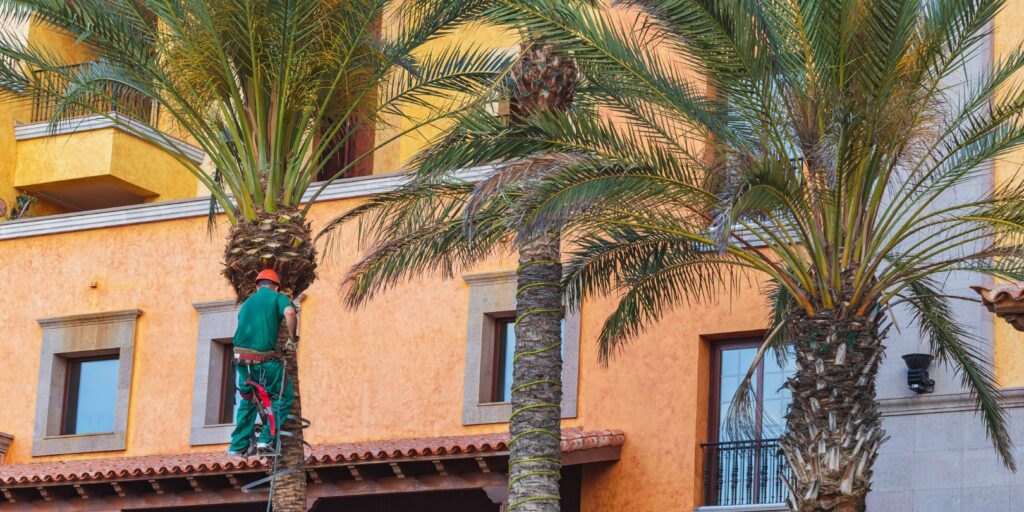Palm Tree Trimming: A Step-by-Step Guide

Do you have a few palm trees in your yard that need a little TLC? If so, then you’re in the right place. This guide will walk you through properly trimming your palm trees. With the right tools and the right techniques, you’ll have your palm trees looking tidier in no time.
In this guide, we’ll discuss the best tools for palm tree trimming, the best times of year to trim your trees, the proper way to prune and shape your palms, and the best practices to ensure your trees look their best. With this step-by-step guide, you’ll be able to give your palms the care they deserve while keeping your yard looking its best.
Tools Required
When it comes to trimming a palm tree, you will need some fundamental tools. The most essential tool is the saw — either a hand saw or a pole saw. If you trim smaller palm fronds and shorter branches, a hand saw should be sufficient. However, if you are removing larger branches, you will need the superior cutting power of a pole saw to reach higher branches from a distance safely. Additionally, you may need gloves, gardening shears, and a ladder to access the tree’s taller parts.
Preparation
Before you begin your trimming job, it is important to take certain preparatory steps. First, check the area around the tree for any objects that might get damaged during the trimming process. Make sure to cover up any garden furniture or other items close to the trunk of the tree with an old sheet or tarp. You should also inspect the palm tree for structural damage (such as broken or dead branches) and remove them with your saw or shears before starting the trimming process.
Trimming the Fronds
Before trimming the leaves of your palm tree, ensure that all your safety gear is on properly and that you have everything at least three feet away from your tree. Using either your saw or shears, start cutting off fronds that are damaged or too heavy for the tree’s structure to support them properly (called “skirt fronds”). This way, you can lighten up the load that the tree has to bear and thus improve its overall health in addition to its appearance. Be careful not to damage any remaining healthy fronds while cutting — you may want to use gardening shears for this purpose so as not to risk damaging them with more powerful tools such as an electric pole saw.
Tip Trimming
After getting rid of heavier fronds, it is time to move on to “tip trimming”; this involves trimming off dead tips from healthy leaves to improve their overall appearance and shape while preventing disease from spreading throughout the rest of the canopy. To do this accurately and safely, use sharp hand pruners suitable for creating neat cuts without leaving jagged edges; be sure not to cut all leaves back at once as this could lead to over-trimming, adversely affecting the plant’s health.
Removing Large Branches
If your palm tree has grown too large or any branches or trunks are blocking access routes or views from nearby buildings/structures, they may have to be removed with a pole saw for these potential hazards to be eliminated safely and efficiently. Be sure to assess each branch carefully before cutting to determine how much wood you should remove from each section; it is important here not to remove too much wood from each one as this could leave the adjacent parts of the trunk vulnerable and open them up potentially hazardous organisms such as fungi or bacteria into them which may cause further rot or decay over time.
Dressing Wounds
No matter what type of pruning you have done on your palm tree, it’s a good idea to treat any wounds left behind by cuts quickly and correctly to prevent diseases such as fungus infiltrating them; apply a commercial wound dressing over any cuts (following instructions on the product label) as soon as possible after pruning has stopped for best results. The damage should remain covered until it has healed completely before removing it altogether — this could take anywhere between several months up to around two years, depending on climate conditions during that period.
Releasing the Palm Tree
Once all wounds have been treated and healed, it is finally time to release your palm tree from pruning work. This may include removing ropes or ties from earlier in the pruning process as well as reopening pathways for light and air circulation again by removing debris if needed. This will allow the tree to return back into its natural state without hindrance, which could stop necessary growth processes from taking place normally again after having just been trimmed.
Maintenance
It’s important not only when trimming but also afterward that you regularly inspect your palm trees for any potential problems with diseased fronds, branches, or roots so they can be prevented from becoming serious issues. Keeping branches sufficiently watered throughout the hot summer months is also necessary, especially so they don’t become too dry from previous pruning work.
Conclusion
When it comes down to it, taking care of your palm trees is not a difficult task. With the right tools, preparation, and the proper trimming techniques, you’ll have your palms looking tidier in no time. Whether it’s trimming off dead fronds or removing heavier branches, you can trust that this step-by-step guide has provided you with all the information you need to ensure that your palm trees stay healthy and attractive. With just a bit of effort, you can keep your yard looking its best and give your trees the care they deserve.
